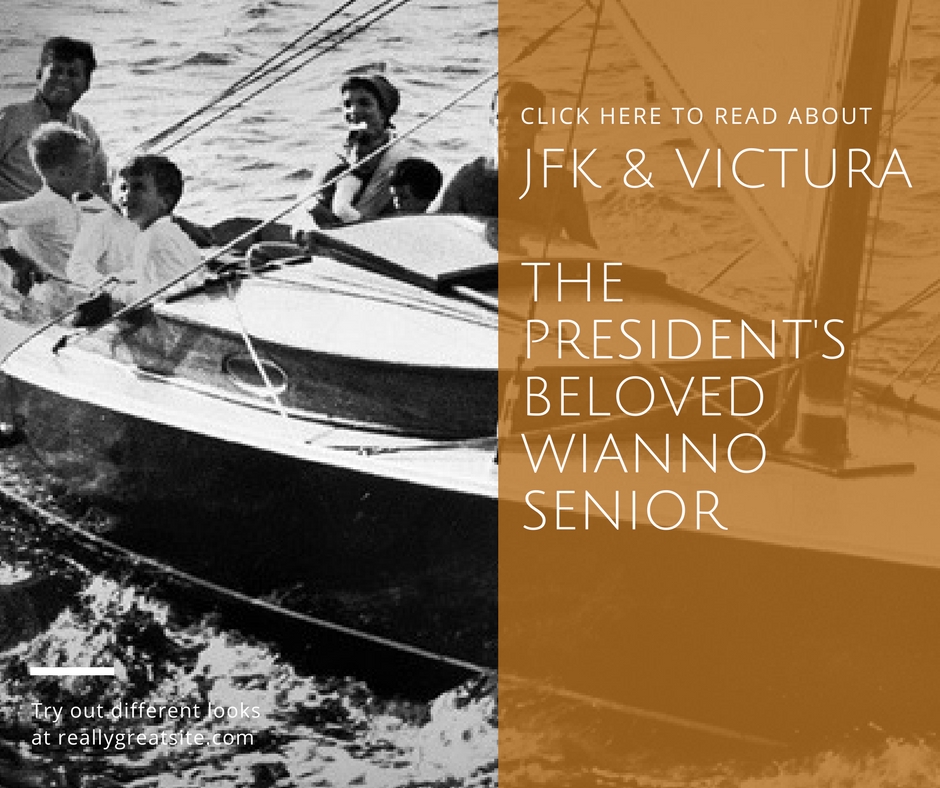THE WIANNO SENIOR
25-foot gaff-rigged sloop.
Osterville, Massachusetts proved itself to be a charming site, surrounded by water on three sides, as a summer location to a number of businessmen and their families in the late 19th century. They would ride the train down from Boston and take a one hour ride by horse-driven coach over from West Barnstable. Strongly encouraged by friend and Boston financier, Henry Day, they settled in the southeast patch of the village in a section known as Wianno, so named after Iyanough, the chief of the Native American tribe from whom the area had been bought by the first settlers in 1664.
In another section of Osterville, nestled in a marshy section of West Bay, lived a family of Crosby’s. Not just one family, but several families of Crosby’s who had an established reputation as boatbuilders. Folklore had them designing the first Crosby catboat via the means of a séance (Read more about this in the Ghost from the Past section on our Eight Generations page). They had an innate sense of design that became so apparent when the half models they carved came to fruition. They knew their craft, had an instinctive sense for sailing and respected their unique Nantucket Sound characterized by heavy winds from the southwest, strong currents and sandy, shallow shoals.
A favorite pastime of Wianno’s summer residents was racing sailboats. The notion of several boats made in a duplicate design hadn’t been introduced at this time. The local races were boats consisting of 15’ to 25’ “jib-and-mainsail” boats (the word “sloop” had not been adopted yet) to a variety of sizes of catboats. This meant a complicated system with a number of handicaps and time allowances per mile. Competition among the skippers wasn’t deemed fair as the design of a boat often gave a skipper advantage over another.
Based on a concept developed in England to simplify racing and highlight a skipper’s prowess and strategy rather than size of boat, renowned New England-based yacht designer, Nathanael Herreshoff, in 1905, provided the New York Yacht Club with one-design to be sailed by their racing fleet, a 30 foot boat, known as the New York 30. This boat soon became popular as did his 12 ½ single design used for racing by Massachusetts’s Beverly Yacht Club. Both Herreshoff classics, are still racing to this day and these racing boats, and other class designs to follow, are called “one-designs.”
A few years after Herreshoff created his design, Henry Day, and Commodore Dowse of the Wianno Yacht Club (established as an official racing club by Massachusetts in 1901) met to discuss this new concept of a one-design for their members. In the fall of 1913, these gentlemen approached H. Manley Crosby, owner of Crosby Yacht Building & Storage Company, one of six Crosby yards lining the North Bay of Osterville at that time, to come up with a one-design suitable for their needs. H. Manley used his inherited talent, skill and experience to design a 25’ gaff-rigged, self-bailing sailboat with smooth topsides; a freeboard that was higher than the average design of that time; a long end, a round-front cabin trunk; and carrying a keel/centerboard. During that first winter, fourteen boats were built, including one for H. Manley, and all were sold to the Wianno Yacht Club racing crowd for $600 each.
The boat was originally referred to as the “Crosby 17-1/2” or the “Class P”. The name “Wianno Senior” did not come about until 1922 with the introduction of the “Wianno Junior” as a training boat for the younger sailors in the fleet. In the sport of sailboat racing, the summer residents of Wianno saw that it was the perfect venue for their children, both sons and daughters, to learn to “play fair”; to navigate, so to speak, the lessons and challenges of life such as, respect, manners, responsibility, etc. So began the century-long institution of generations of a family sailing their “Senior”, passing it on to the son and daughter, who pass it on to theirs…upgrading through refits or replacement of hulls and/or rigs along the way.
A record book belonging to the Edgartown Yacht Club disclosed that in the early 1930’s that the Wianno Senior had extended its reach in Nantucket Sound to include Vineyard Haven, Bass River, Hyannis Port, Quisset, Woods Hole and Edgartown.
In 1946, with more than 100 boats populating Nantucket Sound, organization and standardization deemed prudent and the Wianno Senior Class Committee was formed *(see the Wianno Senior Class Association below) . This group of a broad spectrum of 15 Senior enthusiasts prepared class rules and, in collaboration with Crosby Yacht Building and Storage Co, set out the construction specifics. Now, more than ever, success on the race course was the result of the preparation by, and the ability of, the skipper and crew.
As the wooden Seniors were glaringly showing their age in the 1970’s, and their upkeep deemed very expensive, discussions of introducing a fiberglass design spread amongst the fleet. The three surviving sons of Senior designer, H. Manley Crosby – Horace “Bunk” (Horace M.), “Uncle Max (H. Manley) and “Uncle Bill” (Wilton) – weren’t going to see the business go fiberglass. They decided it was time to get out. The yard was sold in 1972 and renamed Crosby Yacht Yard. Uncle Bill, Uncle Max, Bunk and H. Manley’s grandsons, Bill, Brad, Teddy, Gus and Malcolm stayed on at the yard and worked their craft.
The last new wooden Wianno Seniors were built at Crosby Yacht in 1976 and in 1977 Crosby Yacht, Inc. changed hands once again and was now “Crosby Yacht Yard, Inc”. After a decade long drought, the Wianno Senior Class Committee, fearing their beloved mascot to be displaced by the up and coming fiberglass J24, made a commitment to create a fiberglass Wianno Senior. The Osterville Historical Society, replete with Crosby boat memorabilia and collections, approved sponsoring a Wianno Senior fiberglass mold, only if!, it looked exactly as the original and had genuine wooden spars and trim. Distinguished naval architects Sparkman & Stevens were commissioned for the project and “Design 2498” was created. The resultant fiberglass Senior, #174, built at Crosby Yacht Yard in 1986: true to the original visually and when she’s underway. The only striking difference to those who sailed both the wood and the glass Senior was the difference in the sound it made as it moved through the water.
In 2004, after bringing two wooden Seniors across the Atlantic to the Mediterranean and restoring them, a trio of Italian Senior lovers approached the Wianno Senior Class Association to ask for the license to build and distribute the boat in Europe. Under the agreement then signed with WSCA, “Wianno Senior Italia” was able to construct and promote Wianno Seniors in Europe. With a strong desire to compete and win, but until the Seniors can form a “one-design” class of their own, the Italians compete in such classes as the “Spirit of Tradition” category in regattas, for example, the Panerai Classic Yacht Challenge.
E.M. Crosby Boatworks, was approached by the Wianno Senior Class Association to build fiberglass Wianno Seniors in October 2010. E.M. Crosby’s eagerly accepted the honor and privilege. Upon receiving fiberglass components, they then fashion, fit, and install the wooden components of the boat, as well as building and outfitting the solid Sitka spruce spars with hardware, etc. Along with Crosby Yacht Yard, Inc. the two yards are the only boatbuilders in the country licensed by the Wianno Senior Class Association to build the legendary Wianno Senior.
CONSTRUCTING THE WOODEN SENIOR
Eldredge Arnold Photo Collection, Courtesy of the Osterville Historical Museum
THE 2003 CROSBY YACHT YARD FIRE
Ned Crosby, on December 10, 2003, was living in his father’s former work shop, fondly known as the “Little Shop”, which is across the channel, southeast, from Crosby Yacht Yard. He was taking his last walk with the dogs that evening when he heard crackling noises; he was the first one to call it in. The five alarm fire that then ensued was in the main storage shed of Crosby Yacht Yard, the one that stored all of the Seniors…. Had the gentle breeze that night been coming from the opposite direction, “That fire would have gone all the way to Wimpy’s,” a fireman was overheard saying. Next to Cat 3 hurricanes, fire in an old boat yard is the more pervasive threat. Aged wood, packed closely together is just a powder keg ready to go off. Still of unknown origin, it spread to the yard next door, Oyster Harbors Marine. Firefighters and apparatus from COMM, Cotuit, Hyannis, Barnstable, West Barnstable, Mashpee, Sandwich, Falmouth, Otis and Yarmouth responded to the scene. Approximately 14 engines, 6 ladder trucks, a heavy rescue, 5 ambulances, a fireboat and over 7 chief officers, along with over 110 firefighters fought the fire for several hours before bringing it under control. Orders for new Seniors for replacement were made over the phone while at the fire and confirmed with a virtual “handshake”. Through the quick, deliberate, thorough actions by the incredible firemen, no one, miraculously, was injured, the same, could not be said for the Seniors. Twenty-one Seniors, 2 glass and 19 wood, were lost in the fire, a crushing and devastating loss to each owner and such a catastrophic blow to the fleet.
Malcolm Crosby knew the order in which each Senior stood as it was on jack stands in the storage shed. He knew which bronze fittings and builder’s plagues, left in the ashes, belonged to each boat. He gathered up the “personal effects” of each Senior and very respectfully handed them over to the owners in a gesture of condolence.
Like a Phoenix rising, the Wianno Senior rose victoriously out of the ashes of its greatest tragedy. Fifteen members placed orders in the next few years and the Wianno Senior still competes on Nantucket Sound on summer weekends on the Cape, as they have for over 100 years.












































